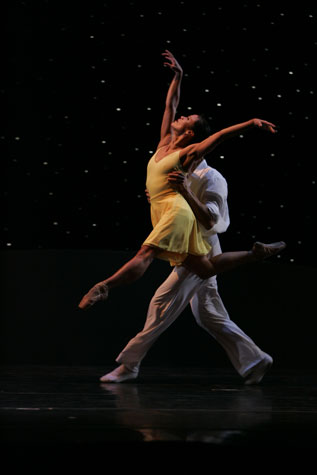
UPLIFTING Guerrero and Bauzys. Photo: THOMAS NOLA-RION |
The cat is back; the clock is back; the fire is back. And they’re all brought to life by dancers in Festival Ballet Providence’s reprise of Viktor Plotnikov’s Cinderella (April 30 through May 2 at the VMA Arts & Cultural Center).
This is not your ordinary Cinderella, even though it is performed to Sergei Prokofiev’s 1943 score. There have been several ballet versions since Cinderella premiered in 1945, but Festival’s artistic director Mijhailo Djuric wanted something original for his company, and he turned to Boston-based choreographer Plotnikov.
The ballet premiered — to great success — in 2007, but the rehearsal time for something that is in the process of being created never seems long enough. Djuric likens it to painting something and letting it sit for a few months before exhibiting it. That opportunity didn’t exist for Cinderella until he made a decision to do it again and, in consultations with Plotnikov, they agreed that some revisions could make the ballet even better.
That was particularly true for Act I, where they wanted to make sure that the audience could tell “who is who and what is happening,” in Djuric’s words.
“It is still a story ballet, though it is done with a different vocabulary that’s not classical,” he explains. “The story needs to be told well, and Viktor’s an excellent storyteller.”
Plotnikov’s full-length work with Festival began with Carmen and The Widow’s Broom and garnered national attention for Loof and Let Dime, set to Robert Wilson’s prose poem, and Coma, a meditation on illness and death.
In Cinderella, as in Chris Van Allsburg’s The Widow’s Broom, the story is ostensibly for children, though the themes and the emotional content have appealed to generations of adults. In Plotnikov’s vision, Cinderella is a very positive person, coping with life’s vagaries with a child-like optimism.
Thus, the ballet opens with a playful cat (Ilya Burov) who amuses Cinderella (Leticia Guerrero/Vilia Putrius) and becomes a kind of mascot for her. Her two stepsisters (Erica Chipp, Lauren Menger, and Jennifer Ricci alternate roles) and stepmother (Lauren Knightly or Vilia Putrius) are rude and downright mean to her, but she rises above it and seeks out her father (Mark Harootian) for comfort.
He gives her a ball, emblematic of many other balls, of various sizes and colors in the ballet, along with cones and cubes that stand in for toys and furniture. Plotnikov and set designer Alan Pickart also have dancers carry large fiberglass panels across the stage to indicate scene changes, as dancers duck behind and around them.
In keeping with Plotnikov’s modern choreography — hands reach out with palms up; arms pinwheel; bodies undulate; feet twist inward; there’s floor movement throughout — props and costumes are contemporary. When the four seasonal fairies befriend Cinderella, Autumn has a golf club, Summer has sunglasses, Spring is dressed in spring green and sky-blue, and Winter is an ice-skater. In addition, Cinderella arrives at the ball in a golf cart, and the Prince (Mindaugus Bauzys/Alexander Akulov) later searches the world for her, traveling by plane, train, and car.
Plotnikov likes to incorporate everyday gestures into his choreography — tying a tie, buffing one’s nails, stumbling, waving hello. All tell part of the story and make the character come alive.